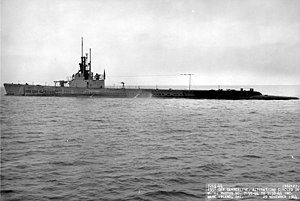 USS Gato off Mare Island Navy Yard, on 29 November 1944
| |
| Class overview | |
|---|---|
| Name | Gato class |
| Builders | |
| Operators | |
| Preceded by | Mackerel class |
| Succeeded by | Balao class |
| Built | 1940–1944[2] |
| In commission | 1941–1969[2] |
| Completed | 77[1] |
| Lost | 20[1] |
| Retired | 57[1] |
| Preserved | 6[1] |
| General characteristics | |
| Type | Diesel-electric submarine |
| Displacement | |
| Length | 311 ft 8 in (95.00 m) – 311 ft 10 in (95.05 m)[1] |
| Beam | 27 ft 3 in (8.31 m)[1] |
| Draft | 17 ft (5.2 m) maximum[1] |
| Propulsion |
|
| Speed | |
| Range | 11,000 nautical miles (13,000 mi) surfaced at 10 knots (12 mph)[3] |
| Endurance |
|
| Test depth | 300 ft (90 m)[3] |
| Complement | 6 officers, 54 enlisted men[3] |
| Armament |
|
The Gato class of submarines were built for the United States Navy and launched in 1941–1943. Named after the lead ship of the class, USS Gato, they were the first mass-production U.S. submarine class of World War II.
The Gatos, along with the closely related Balao and Tench classes that followed, accounted for most of the Navy's World War II submarines;[5] they destroyed much of the Japanese merchant marine and a large portion of the Imperial Japanese Navy. In some references, the Gatos are combined with their successors, especially the Balao class.[6][7]
Gato's name comes from a species of small catshark. Like most other U.S. Navy submarines of the period, ships of the Gato class were given the names of marine creatures.
- ^ a b c d e f g h i j k l m n Bauer & Roberts 1991, pp. 271–273
- ^ a b Friedman 1995, pp. 285–304
- ^ a b c d e f g Friedman 1995, pp. 305–311
- ^ a b U.S. Submarines Through 1945 pp. 305–311
- ^ Typical Gato-class submarine diagram, USS MacKinnon website
- ^ Silverstone 1989, pp. 195–204
- ^ Gardiner & Chesneau 1980, pp. 145–147